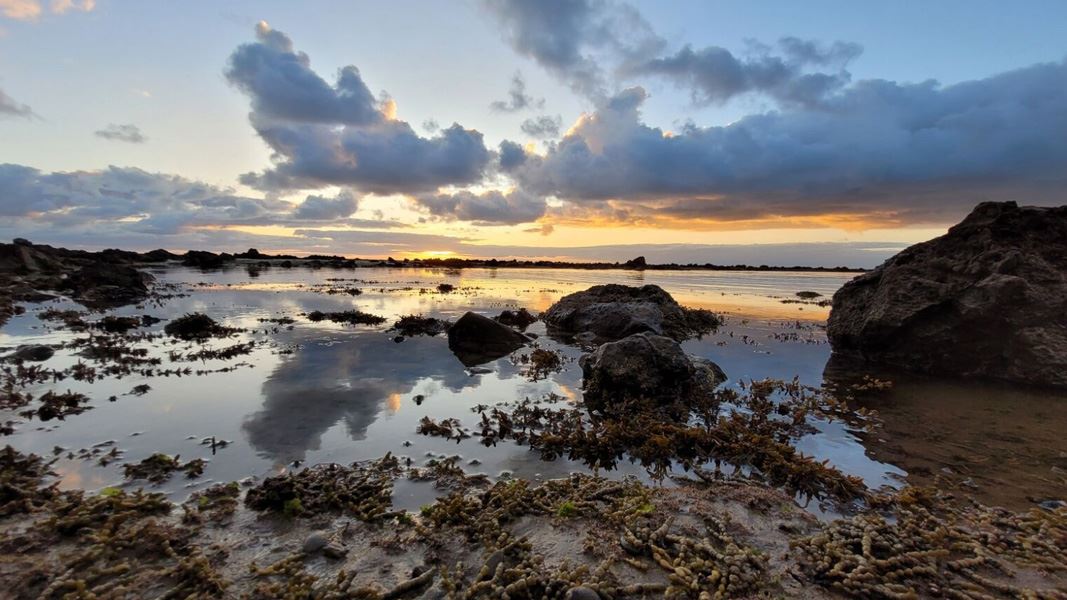The marine reserve was established in 1997 and is 446 hectares.
Rock pools
Visit rock pools - on the large tidal platform you may see octopus, crayfish, and wandering anemones among many other species, including migratory wading birds.
When exploring the rock pools, return any rocks you look under to their original position. This will help protect the plants and animals living on and under them. Also avoid walking on the eel grass beds. Trampling will kill these plants and result in the sand trapped around them being washed away.
Turn off State Highway 2 at Waipawa or Waipukurau.
The drive will take approximately 30 minutes from either town.
From Waipawa follow Pourere and Gibraltar roads to Aramoana. From Waipukurau follow Farm, Motere and Long Range roads to Blackhead.
Poaching
There is evidence of widespread poaching at Te Angiangi Marine Reserve. As at 2013, 20% of marine reserve convictions nationally were for fishing here.
The extent of poaching has compromised scientific study and the integrity of Te Angiangi’s ecosystem.
Report offences to the Department of Conservation on +64 6 759 0350 (office hours), or the 24 hour conservation emergency hotline 0800 DOC HOT (0800 362 468).
The rules
No fishing, seaweed or shellfish gathering is allowed.
All plant and animal life, alive or dead, in the marine reserve are totally protected.The reefs and sea floor are also protected so nothing can be removed from the reserve.
It is illegal to discharge any firearm, or any substance which may harm, or threaten plant and animal life in, or into the marine reserve. It is also illegal to release any plant or animal into the reserve which does not naturally occur there.
Horses and motor vehicles can be ridden or driven along the sand at the top of the rock platform but are not permitted on the rocky areas below mean high water.
Avoid disturbing wildlife. Birds and marine mammals should be observed from a distance and dogs kept on a leash at all times.
At low tide a broad mudstone platform is exposed, revealing beds of Neptune’s necklace, pink coralline seaweeds, and patches of sea grass mixed with a lively rockpool community of fish and shellfish, including golden limpets.
Offshore the interplay of the warm East Cape current and the colder South Wairarapa current means many typically ‘northern’ and ‘southern’ marine species occur in the reserve. Sometimes these can even be seen swimming together, or sheltering in the same crevice. Rock lobsters are conspicuous.
In April 2011 a heavy rainfall event coincided with a shallow magnitute 4.5 earthquake, resulting in inundation of the rock platform by 14 landslides. In places landslides covered the full width of the platform (more than 100 m), completely burying or sweeping away the biological communities living there. Within a few months however relentless wave action had begun to uncover the platform, and positive signs of recovery were evident throughout the intertidal zone. A couple of years later, the reserve had almost completely recovered.
Reporting pests
Find-A-Pest lets you report potential pest species, including marine, plant, animal and fungal species.
If you come across something out of the ordinary, upload a picture to the app and a specialist will help identify it. If it's a biosecurity threat, this will be forwarded to Biosecurity New Zealand. If possible, take photos and record the location and name of the vessel.
Or call the Ministry for Primary Industries' Pest and Diseases hotline on 0800 80 99 66.
Report illegal or suspicious activity
Don't take, disturb, kill or damage anything within the reserve - it's illegal. If you see people taking anything from the reserve, report the activity as soon as possible.
You can call 0800 4 POACHER (0800 476 224) or 0800 DOCHOT (0800 362 468).
It is also an offence to pollute or litter the reserve, discharge any firearm in or into the reserve or erect any structure in the reserve.
The name of the reserve was chosen by Ngāti Kere to honour local history. When Ngāti Kahungunu settled the region, central Hawke's Bay was divided between Te Aomatarahi and Taraia.
Te Aomatarahi, a descendent of Porangahau, was given the lands east of Tukituki River and mana whenua passed to his descendents Tu Mapuhiarangi and Te Angiangi. The area covered by the mana of Te Angiangi included what is now the marine reserve.
Te Angiangi Marine Reserve review
Ngāti Kere holds mana whenua over the area of the coast that includes the Te Angiangi Marine Reserve. Ngāti Kere supported establishment in 1997 so long as DOC agreed to a ‘generational’ review of the reserve. To fulfil that commitment, we partnered with Ngāti Kere to complete a review. The review is important to Ngāti Kere because:
- of the importance of kaimoana/seafood as a staple in families’ diets
- it's a way to help maintain the connection between Ngāti Kere and the reserve.
The review examined:
- the health of marine life within the reserve
- management practices
- community engagement with the area.
We completed the review in 2024 and made thirteen recommendations to improve management of the marine reserve. Read the report below.
Te Angiangi Marine Reserve – A Generational Review (PDF, 1,151K)
Protect our marine reserves
- No fishing of any kind.
- Don't take or kill marine life.
- Don't remove or disturb any marine life or materials.
- Don't feed fish - it disturbs their natural behaviour.
- Take care when anchoring to avoid damaging the sea floor.
DOC Customer Service Centre
| Phone: | 0800 275 362 |
| Email: | napier@doc.govt.nz |
| Address: | Ahuriri / Napier Office |
